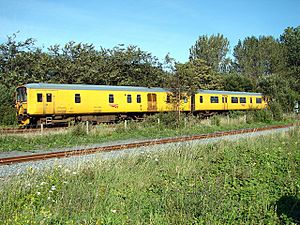British Rail Class 950 facts for kids
The Class 950 is a special kind of train used by British Rail. It's a diesel multiple unit, which means it runs on diesel fuel and has its own engines. Unlike regular passenger trains, the Class 950 was built for a very specific job: checking the railway tracks. It's like a mobile inspection unit!
This train was built in 1987. It shares its basic design, called a "bodyshell," with the Class 150/1 "Sprinter" trains. These Sprinter trains were popular passenger trains built a few years earlier, between 1985 and 1986. So, while the Class 950 looks similar to a passenger train, its inside is very different.
Contents
What is a Track Assessment Unit?
The main job of the Class 950 is to be a track assessment unit. This means it travels along railway lines to check their condition. It makes sure the tracks are smooth, level, and safe for other trains to use.
Why are Track Checks Important?
Checking the tracks regularly is super important for railway safety. If tracks are damaged or uneven, it could cause problems for trains. The Class 950 helps railway engineers find any issues before they become dangerous. This keeps everyone safe when they travel by train.
How Does it Work?
These special trains are fitted with lots of high-tech equipment. They use things like video cameras and laser measurement tools. These tools help them record details about the tracks as they move. Engineers can then look at this information to decide if any repairs are needed.
Design and History
The Class 950 was built to help railway staff do their jobs. Trains like this are sometimes called "departmental" trains. This means they are used by the railway company itself, not for carrying passengers or freight.
Built Like a Sprinter
Even though it's a work train, the Class 950 looks a lot like the Class 150/1 "Sprinter" trains. These Sprinter trains were designed for local and regional passenger services. Using a similar design helped save time and money when building the Class 950.
Images for kids



